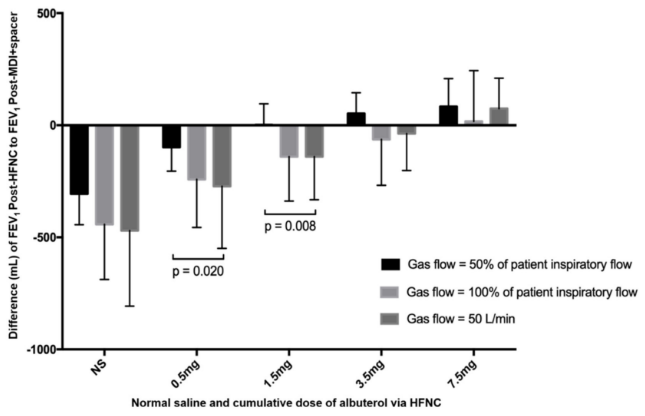A research paper on a randomized controlled trial of bronchodilator delivery via high-flow nasal cannula (HFNC). The primary purpose of the study was to compare the effectiveness of bronchodilator delivery at different gas flow settings. The patients involved in the study all had a history of chronic obstructive pulmonary disease (COPD) or asthma and had a clear positive response to inhaled bronchodilators in an outpatient pulmonary function laboratory.
In the study, patients were randomly assigned to three different gas flow settings: GF:IF = 0.5, GF:IF = 1.0, and GF = 50 L/min. In these settings, patients inhaled saline (control group) and then received different doses of salbutamol via HFNC at 0.5 mg, 1.5 mg, 3.5 mg, and 7.5 mg respectively. After each inhalation, a pulmonary function test is performed to assess the effect of bronchiectasis.

The study results showed that in the setting of GF:IF = 0.5, patients had a better response to a lower dose of salbutamol (1.5 mg), compared with the setting of GF:IF = 1.0 and GF = 50 L/min, reaching A higher proportion of patients expected improvement in lung function. This suggests that in HFNC therapy, setting the gas flow to 50% of the patient's peak inspiratory flow may deliver the drug more efficiently.
In addition, the study also explored the impact of different gas flow settings on drug delivery efficiency and found that a lower GF:IF ratio (such as 0.5) is more efficient in drug delivery efficiency and may reduce the required drug dose, thereby improving the effectiveness of treatment. Safety and economy. Overall, this study provides important clinical data for the use of HFNC in respiratory therapy, supporting the importance of optimizing gas flow settings under specific conditions.
At the same time, it can be seen in the article that using a vibrating mesh nebulizer (VMN) to deliver the bronchodilator albuterol through a high-flow nasal cannula (HFNC) has certain advantages:
Higher inhalation dose and lower line condensation deposits. The article points out that the VMN is placed on the dry side of the HFNC humidifier, so that a higher inhalation dose and lower pipeline condensation deposition can be obtained.
Higher drug delivery efficiency. The results showed that under the airflow setting of GF:IF=0.5, patients responded better to a lower dose (1.5 mg) of salbutamol, and a higher proportion of patients achieved expected lung function improvement. This means that the VMN can deliver drugs more efficiently at this airflow setting.